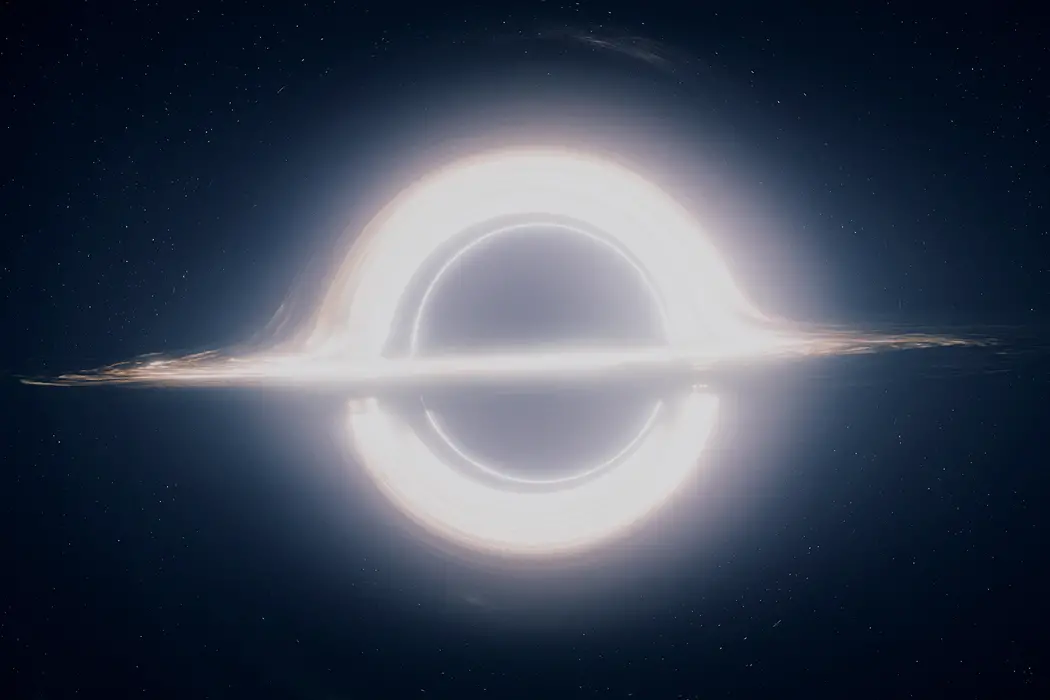Fantasy Science Pt. 25: INTERSTELLAR & The First Real Image Of A Black Hole

Radha has a PhD in theoretical quantum physics. Apart from…
Black holes. Spacetime. Image processing. Have you heard terms like these flying around the science fiction sections of the film/TV world? Have you ever wondered just how accurately these films portray real science? Well, my friends, today is your lucky day: this column, Fantasy Science & Coffee, aims to bridge the gap between science and science fiction in films and popular culture. My hope is to explain things in a fun way – like we’re chatting over coffee.
You may be thinking: who is this person, why does she think she can explain science, and why the heck would I want to have coffee with her? Well, I’m Radha, a researcher in India, who recently submitted a PhD thesis in theoretical quantum physics. I quite like hot beverages. I’ll also pay.

In this twenty fifth part of the series published on the second and fourth Tuesdays of every month, we are going to chat about a major recent breakthrough in science: the first real image of a black hole.
The Black Hole in Interstellar
In 2014, the film Interstellar captivated audiences around the world by its spectacular depiction of a black hole. Dubbed Gargantua, this stellar monster warped spacetime around it in such a way that a nearby orbiting planet experienced time at a much slower rate than Earth did. What made Gargantua fascinating was not just that it gave rise to beautiful storytelling, its depiction was the result of real simulations by physicists, leading to at least two research papers being published in scientific journals.
Kip Thorne, astrophysicist, Nobel Laureate, and Feynman Professor of Theoretical Physics, Emeritus at Caltech, and his team, worked closely with Christopher Nolan on Interstellar, resulting in just about the most accurate rendering of a black hole on screen. It looked like a large circular shadow, surrounded by a swirling ring of light. This was accomplished through simulations based on the predictions of Einstein’s general theory of relativity, because we’d never actually seen a black hole.
Until now.
On Wednesday April 10, 2019, a massive international collaboration consisting of a planet-scale array of eight telescopes called the Event Horizon Telescope (EHT) announced that it had captured the first ever image of a black hole. From the EHT website:
“We have taken the first picture of a black hole,” said EHT project director Sheperd S. Doeleman of the Center for Astrophysics | Harvard & Smithsonian. “This is an extraordinary scientific feat accomplished by a team of more than 200 researchers.”
You know what’s super cool about it apart from showing that general relativity accurately predicts what happens near a black hole? It looks similar to Interstellar‘s Gargantua.
What are we looking at?
This is the first ever image of a black hole.

The black hole lies at the core of the galaxy Messier 87, about 55 million light-years away from us. It looks like a large circular shadow, surrounded by a swirling ring of light. Sound familiar?
The large circular black disk is not the black hole itself, only its shadow, because we cannot directly capture a black hole. Remember that a black hole is an immensely massive object that can warp spacetime so that anything that approaches it, even light, gets sucked in. And we need light to capture an image. Matter and light that approach a black hole are doomed if they cross its event horizon, or the region in which anything that enters cannot leave, due to the immense gravitational pull. (For more about event horizons, check out Fantasy Science Pt. 1: Wormholes In DEJA VU, STARGATE & Real Life)
What we see is the light that moves towards the black hole far enough from the event horizon to simply loop around it and reach our telescopes without falling into the black hole. This is why a black hole casts a shadow that is larger than its event horizon. The more massive a black hole, the larger its shadow, which is how the EHT team could calculate how big it is.
From the EHT website:
The shadow of a black hole is the closest we can come to an image of the black hole itself, a completely dark object from which light cannot escape. The black hole’s boundary — the event horizon from which the EHT takes its name — is around 2.5 times smaller than the shadow it casts and measures just under 40 billion km across.
The ring around the shadow an accretion disk consisting of superheated ionized gas — also known as plasma, essentially a swirling disk affected by the gravity of the black hole. The black hole feeds off this accretion disk. Notice that this disk isn’t uniform; the fainter region depicts plasma moving away from us, and the bright region is plasma moving towards us. From the EHT paper “The Shadow of the Supermassive Black Hole“:
The asymmetry in brightness in the ring can be explained in terms of relativistic beaming of the emission from a plasma rotating close to the speed of light around a black hole.
We appear to be looking at this black hole’s accretion disk perpendicularly. The depiction of Gargantua in Interstellar is what happens when you look at the accretion disk at an angle.
For an in-depth beautiful demonstration of what we are actually looking at and how it compares to Gargantua, check out this video by Veritasium:
How was the image captured?
The black hole is enormous, with a shadow of about 38 billion kilometers in diameter. Yet, since it is so far away, capturing it would be similar to trying to capture the image of an orange on the moon, according to Dr. Katie Bouman, who led the development of the algorithm that pieced together this image. To capture the black hole, one would need a radio telescope the size of Earth, which isn’t possible. Instead, eight radio telescopes around the world coordinated measurements.
Why radio telescopes? A quote by Bouman explains this nicely:
Radio wavelengths come with a lot of advantages. Just like how radio frequencies will go through walls, they pierce through galactic dust. We would never be able to see into the center of our galaxy in visible wavelengths because there’s too much stuff in between.
Once the data was collected, the image needed to be pieced together through image processing. This is where the team’s algorithm, CHIRP (Continuous High-resolution Image Reconstruction using Patch priors), came into the picture. Pun intended.
Think of the black hole image as a jigsaw puzzle. If we had access to a radio telescope the size of the Earth, then we would have all the pieces of the puzzle to easily construct the image. However, since we only had data from eight telescopes located around the world, we didn’t have enough puzzle pieces to create the whole image. The rest of the puzzle had to be fleshed out by intelligent image processing based on various assumptions.
You may wonder whether our own bias of what black holes should look like affected these assumptions and thereby the outcome of the image. The answer is no. A number of independent groups worked with the data to reconstruct the image with different assumptions, and all led to this image of a shadow and accretion disk. The final image was a mixture of their their results.
For more information on how to to take a picture of a black hole, check out this TEDx talk by Bouman:
https://www.youtube.com/watch?time_continue=807&v=P7n2rYt9wfU
What the future holds
Now that we’ve had this fantastic scientific breakthrough, what’s next? For one, this image can tell us a lot about black holes and physics, and will be heavily studied. Other telescopes may join EHT, the algorithm may be further developed, and the image may be further refined. And I imagine that our future holds many more beautiful and accurate science fiction stories à la Interstellar.
More to Explore
Videos
Katie Bouman’s talk at Caltech, April 13 “Imaging a Black Hole with the Event Horizon Telescope” (2019)
Veritasium: First Image of a Black Hole! (2019)
Veritasium: How to Understand the Image of a Black Hole (2019)
TEDxBeaconStreet How to take a picture of a black hole by Katie Bouman (2016)
Papers
Interstellar papers by Kip Thorne and his team:
Gravitational Lensing by Spinning Black Holes in Astrophysics, and in the Movie Interstellar
Visualizing Interstellar’s Wormhole
Papers from the EHT Collaboration:
- Paper I: The Shadow of the Supermassive Black Hole
- Paper II: Array and Instrumentation
- Paper III: Data processing and Calibration
- Paper IV: Imaging the Central Supermassive Black Hole
- Paper V: Physical Origin of the Asymmetric Ring
- Paper VI: The Shadow and Mass of the Central Black Hole
Books
The Science of Interstellar by Kip Thorne
Articles
Scroll.in: Watch Katie Bouman, the scientist behind the first-ever black hole image, disclose her future plans (2019)
NASA Jet Propulsion Lab at Caltech: How Scientists Captured the First Image of a Black Hole (2019)
PBS: Katie Bouman ‘hardly knew what a black hole was.’ Her algorithm helped us see one (2019)
MIT News: A method to image black holes (2016)
Wired: Wrinkles in Spacetime: The Warped Astrophysics of Interstellar (2014)
Resources
Event Horizon Telescope Homepage
Interstellar Education website
Does content like this matter to you?
Become a Member and support film journalism. Unlock access to all of Film Inquiry`s great articles. Join a community of like-minded readers who are passionate about cinema - get access to our private members Network, give back to independent filmmakers, and more.
Radha has a PhD in theoretical quantum physics. Apart from research, she consults on sci-fi screenplays/books. In her free time, she cosplays and irritates her three cats. Bug her on Twitter: @RadhaPyari













